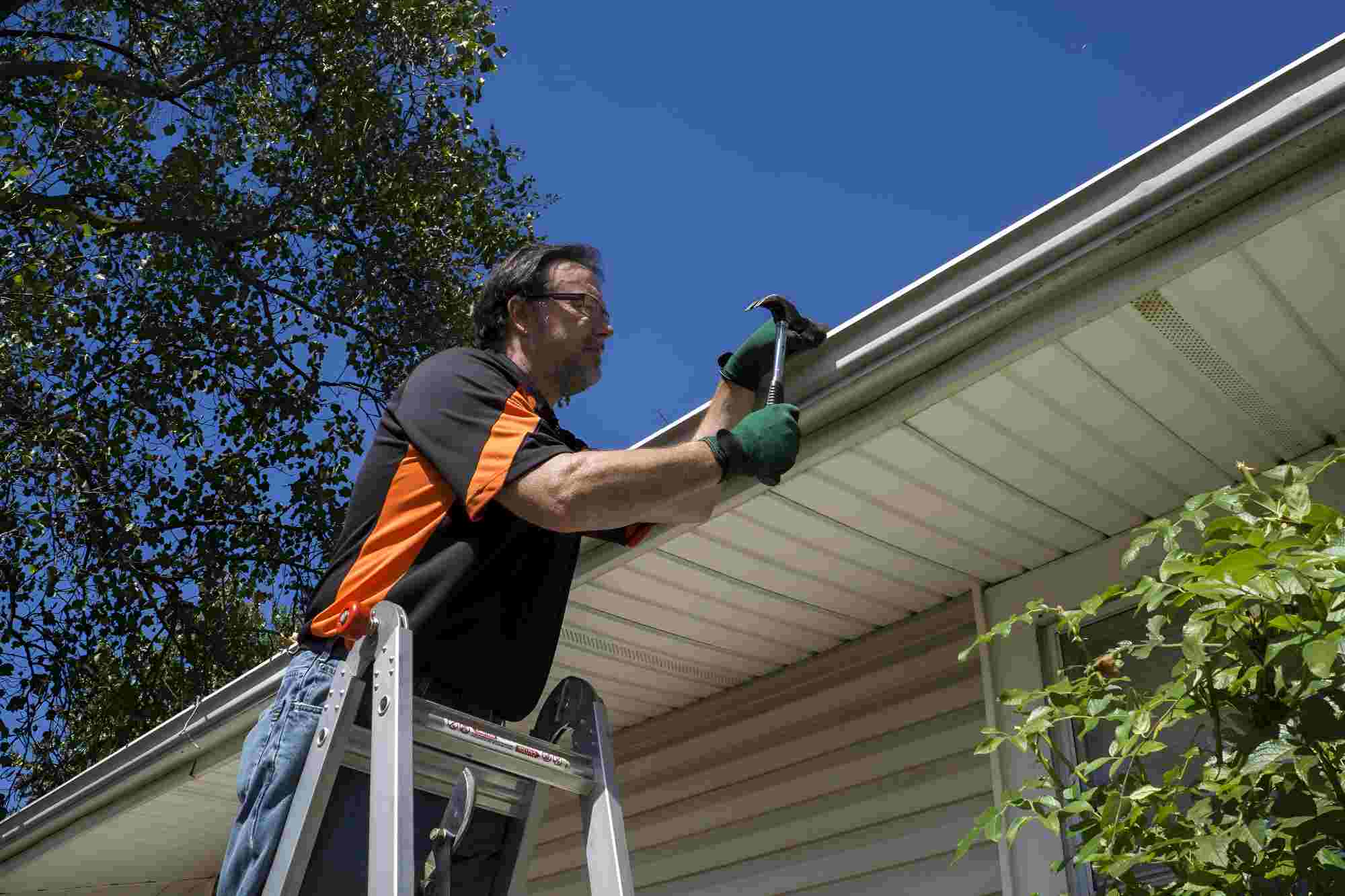Gutter overflow can turn a rainy day into a homeowner’s nightmare. When your gutter overflows, it can lead to serious water damage to your home’s exterior and foundation. But what exactly causes overflow, and more importantly, how can you prevent it from happening?
In dis blog post, we’ll explore the common culprits of overflow and share practical tips to keep your home safe and dry, regardless of the weather. Keep on reading!
Table of Contents
Understanding Gutters
Gutters are designed to channel water away from your home’s foundation. When rain falls on your roof, gutters ensure that the water doesn’t simply drop off the edges but instead, is directed safely away. They are typically made from materials such as aluminum, vinyl, steel, or copper and are installed along the edge of the roof.
Their efficiency depends on regular maintenance, including clearing debris and checking for cracks or gaps. Understanding how your gutters work and why their crucial can help you prevent potential hefty repair costs associated with water damage.
Causes of Gutter Overflow
There are several reasons why gutters might overflow. dis can be a significant issue, leading to serious damage if not addressed. Let’s delve into the most common causes that could turn a properly functioning gutter into a potential hazard.
Incorrectly Sized Gutters
Incorrectly sized gutters are a common cause of overflow. If the gutters are too small, they may not be able to handle the volume of rainwater coming off your roof, leading to overflow.
On the other hand, if the gutters are too large, they may not properly redirect water away from your home, causing pooling and potential damage. Therefore, it’s crucial to ensure your gutters are accurately sized for your house, taking into account the roof’s size and the average rainfall in your area.
Debris Accumulation
Debris accumulation is another significant cause of gutter overflow. Leaves, twigs, and other debris can clog your gutters, preventing the drain of water.
When water can’t flow freely, it overflows, potentially damaging your home’s exterior and foundation. Regular cleaning and maintenance can prevent dis issue, ensuring your gutters are free from any obstructions and can properly divert rainwater away from your home.
Clogged Downspouts
Clogged gutters are another common cause of gutter overflow. Downspouts are designed to direct the water collected by gutters away from your home.
However, they can become blocked by leaves, twigs, and other debris. When a downspout is clogged, water cannot flow out and is forced back into the gutters, leading to overflow. Regular downspout cleaning is essential in maintaining proper gutter function and preventing overflow issues.
Improper Slope or Alignment
An uneven slope or misalignment can make gutter overflow worse. There needs to be a small slope for the gutters to direct water to the downspouts. If you don’t level your gutters, water will pool and overflow when it rains hard.
If, on the other hand, the slope is too steep, the water can flow faster and spill over. So, the right alignment and slope make sure that water flows smoothly, stopping overflow and the damage that can come from it.
Ice Dams
Ice dams are a common winter problem that can cause gutter overflow. They form when snow on the roof melts, flows down, and refreezes at the gutter’s edge, forming a dam. dis ice dam traps melting snow, preventing it from draining through the gutters.
As the water backs up behind the dam, it can leak into the home and cause significant damage. Regular roof maintenance and proper insulation can help prevent the formation of ice dams.
Damaged Gutters
Overflow is also often caused by gutters that are broken. Breaks, cracks, or holes in the pipe can stop the flow of water, which can cause it to spill over or overflow.
Also, water may pool in some places instead of flowing to the downspout if the gutters are sagging. To keep gutters working and avoid problems caused by overflow, they need to be checked regularly and fixed as soon as any damage is found.
Prevention Methods
Let’s explore some effective prevention methods that can safeguard your gutters from overflow. These strategies focus on regular maintenance and the use of gutter-enhancing accessories to ensure optimal water flow.
Regular Cleaning
Regular cleaning is the most important part of keeping gutters in good shape and stopping them from overflowing. dis means cleaning out the gutters and downspouts of dirt, leaves, twigs, and other junk that builds up there.
A deep cleaning at least twice a year, preferably in the fall and spring, can greatly lower the chance of clogs and the overflow that follows. Homes that are surrounded by trees may need to be cleaned more often. This easy preventative step will help your gutter system work better for a long time.
Gutter Guards or Screens
Gutter splash guard, also called screens, are add-ons that can help keep debris out of your gutters. Their job is to protect the gutter by letting water flow through but keeping leaves, twigs, and other debris out.
These add-ons can make cleaning your gutters much less often, so they are a good investment for long-term gutter maintenance. But you still need to check your gutters regularly because small things can still get through and block them.
Proper Downspout Maintenance
Gutter overflow can be avoided by keeping your downspouts in good shape. dis means cleaning and checking for blockages regularly to make sure water flows freely. Downspouts should also be set up so that water flows at least 5 feet away from the foundation of your home to avoid water damage.
Lastly, you might want to use downspout extensions or splash blocks to better direct the water. Gutter overflow is much less likely to happen if you keep your downspouts in good shape and working.
Correct Installation and Repairs
Installing gutters correctly and fixing them when they break is very important for keeping them in good shape. When installing gutters, they should be set up with the right slope to let water flow properly. Also, they should be securely attached so that they don’t sag or move over time.
Regular checks are important to find and fix any damage right away; cracks, holes, or loose fasteners can all make your gutter less effective. By hiring a professional for installation and major repairs, you can be sure that the job will be done right and that your home’s structure will be protected.
Trim Overhanging Branches
Trimming overhanging branches is an important part of maintaining gutters. When trees near your house drop leaves and twigs, they can get stuck in your gutters and downspouts and cause water to overflow.
Cutting these branches back regularly will not only cut down on the amount of trash that ends up in your gutters, but it will also help keep your roof from getting damaged by falling branches. So, taking care of your trees is an active way to keep your gutters clear and the outside of your house in great shape.
Ice Dam Prevention
Avoiding ice dams is important for keeping your gutters working during the winter. Ice dams can be avoided by making sure your attic is properly insulated and ventilated so that as little heat as possible is lost from the house.
dis keeps the snow on the roof from melting too quickly. Keeping your roof clear of snow regularly can also help prevent ice dams.
Putting a heating cable on the roof can give you extra protection by keeping snow and ice from building up. By taking these precautions, you can keep your gutters from overflowing and your home from getting water damage in the winter.
Professional Inspection
A professional inspection is an important part of keeping your gutters in good shape. Only professionals can find and fix potential problems that an average person might not be able to see.
They can find signs of damage, wear and tear, and misalignment that could cause the gutters to overflow. Professional inspections should be done regularly, ideally once a year. This can help stop major damage and save homeowners a lot of money on repairs over time.
The Cost of Neglect
Not taking care of your gutters can cause big problems that cost a lot of money to fix. If your gutters are too full, water can damage the outside of your home, which can cost a lot to fix and lower its value.
More importantly, constant water overflow can weaken your home’s foundation, which can lead to problems with its structure that can cost thousands to fix. Moisture getting in can also cause mold and mildew to grow, which is bad for people’s health.
So, not taking care of your gutters has costs that go beyond money; they could affect the health of your family and the longevity of your home. Maintenance that is done regularly and carefully is a small investment compared to dis.
Learning How to Prevent Gutter Overflow and Keep Your Home Protected
Gutter overflow is not only a nuisance but can also cause significant damage to your home. By understanding the common causes, such as clogs and poor installation, you can take steps to prevent it.
Regular maintenance and investing in quality gutters and guards can go a long way in ensuring your gutter system functions properly. Don’t ignore dis crucial aspect of home maintenance, take action today to protect your home and avoid costly repairs.
Remember, prevention is always better than cure. So, don’t wait any longer – take care of your gutters now!
For more helpful tips, browse our blog regularly!





